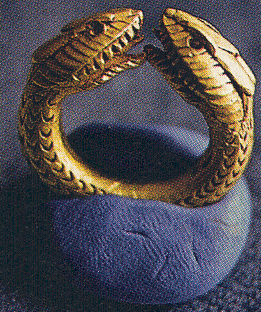Image Details

Cynthia L. Thompson
Pagan symbol. Teeth bared and tongues darting, two snake heads glower fiercely on the ends of the open hoop, on which V-shape incisions represent the scales of the snake’s body. The dramatic quality would be heightened if the gaping eye sockets still held their original gems. The ring’s above-average diameter and weight suggest that a man wore it. Found at Pompeii, and now in the National Archaeological Museum of Naples, this ring dates to some time before 79 C.E., the year Pompeii was destroyed by a volcanic eruption.
Rings in antiquity often depicted snakes, for they were thought to protect the wearer from harm. Anathema to Christians, this pagan belief guaranteed the continuing condemnation of such rings even after the easing of strictures against gold rings used as seals.
